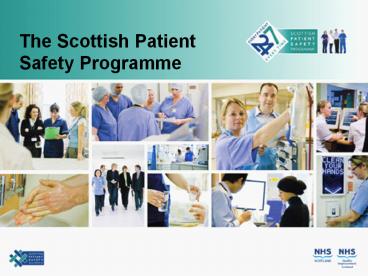The Scottish Patient Safety Programme - PowerPoint PPT Presentation
1 / 19
Title:
The Scottish Patient Safety Programme
Description:
The Scottish Patient Safety Programme Scotland at the forefront - a whole healthcare system approach A strategic development priority for NHS Scotland An explicit and ... – PowerPoint PPT presentation
Number of Views:73
Avg rating:3.0/5.0
Title: The Scottish Patient Safety Programme
1
The Scottish Patient Safety Programme
2
The vision Scotland leading the way in patient
safety
- Scotland at the forefront - a whole healthcare
system approach - A strategic development priority for NHS Scotland
- An explicit and tested approach to improving
patient safety - Build on foundations laid through audit, clinical
effectiveness and clinical governance - Alignment with wider NHS QIS Patient Safety work
3
(No Transcript)
4
Adverse Events in Hospital
- 3.7 Harvard 1991
- 16.6 Australia 1995
- 10.8 London 2001
- 3 million bed days in UK
- 1 billion per annum in UK
- 50 PREVENTABLE
5
Reliability
- McGlynn, et al The quality of health care
delivered to adults in the United States. NEJM
2003 348 2635-2645 (June 26, 2003) - 439 indicators of clinical quality of care
- 30 acute and chronic conditions
- Medical records for 6712 patients
- Participants had received 54.9 of scientifically
indicated care (Acute 53.5 Chronic 56.1
Preventative 54.9) - Conclusion The Defect Rate in technical quality
of American health care is approximately - 45
6
- 17 years to apply 14 of research knowledge to
patient care. - Balas EA, Boren SA. Managing clinical knowledge
for health care improvement. Yrbk of Med
Informatics 2000 65-70
7
Scottish Patient Safety Alliance (SPSA)
- Launched 2007 by the CMO
- Aims to strategically improve safety for
Scotlands hospital patients - SPSP is the first programme of work of SPSA
- Brings key healthcare organisations together
8
Scottish Patient Safety Alliance Key Partners
- The Scottish Government
- NHS Scotland
- NHS QIS
- Royal Colleges and Professional bodies
- World leading experts on patient safety
- Patients
- NHS Education for Scotland
- Health Protection Scotland
9
Delivery
- Led by National Co-ordinator Jane Murkin, and the
National - Co-ordinating Team, based within NHS Quality
Improvement Scotland (NHS QIS) - Jason Leitch, National Clinical Lead for Safety
Improvement - Ros Gray, Wendy Sayan and Jane Ross, National
Facilitators - Technical partner the Institute for Healthcare
Improvement (IHI) - Pat OConnor, National Patient Safety Development
Advisor - Scottish faculty
- NHS boards
10
Our Theory
- Build a compelling case for change
- Work on processes and outcomes that engage hearts
minds - Reduce waste and redundancy
- Work at the coal face and at the executive level
- Data feedback, data feedback, data feedback
- Set the tempo!
- Changes in process and outcomes are directly
connected - The changes being tested, when fully implemented,
will lead to large system aims
11
Primary Drivers
Secondary Drivers
Scottish Patient Safety Programme
Driver Diagram
Demonstrable results to community Clear, shared
measurement set Visible on all senior leader
agenda PSA represents demonstrates
cohesive, united programme National Policy
alignment
Scottish Government Sets Patient Safety as
Strategic Priority Boards Accept Safety as Key
Strategic Priority for Effective Governance
Robust, evidence based proven clinical
changes IHI/QIS Team Expert at Content,
Coaching and Programme Management Align SPSP
with national improvement programmes and
measures
Ownership of agreed upon set of outcomes Review
of outcomes at each meeting Quality and safety
comprises 25 of agenda Recovery plans for unmet
outcomes Infrastructure supports improvement and
measurement Involve patients in safety
Improve Safety of Hospital Healthcare Services
in Scotland
Acceptance of pragmatic science Royal College
Supports PSA Programme
International expert clinical faculty Faculty
expert at improvement methods and
coaching Programme design and structure
Inventory national programmes and
measurements Meet with programme leader to
understand programme intent, audience,
history Harmonize our metrics
12
Aims
- 15 reduction in mortality
- 30 reduction in adverse events
- Reduce healthcare associated infections
- Reduce adverse surgical incidents
- Reduce adverse drug events
- Improve critical care outcomes
- Data for improvement
- Develop and build a quality improvement and
patient safety culture in our hospitals - Build in long term sustainability and capability
to drive this approach at all levels
13
Workstreams
- Leadership
- Critical care
- General ward
- Medicines management
- Peri-operative
14
Key objectives
15
SPSP Engine and Timeline
Organisational Self Assessment
P
P
P
A
D
D
A
D
A
S
S
S
2 day Kickoff
2 day LS
2 day LS
2 day LS
Continued Support
Alignment with national work
Support Expert clinical faculty Site
Visit Networking events Phone conf Listserv
Assessments Monthly Reports via web
Key Changes Improvement Measures
Jan 09
Jan 11
Jun 08
Jun 09
Jan 08
Oct 07
16
Building a sustainable infrastructure for
improvement
- Learning sessions
- National capacity and capability events
- Patient Safety Officer
- Fellowship programme
- Developing Scottish Faculty
- Improvement Advisors
17
Progress so far
- Over 600 Leadership walkrounds have now taken
place throughout Scotland. - 52 pilot wards throughout Scotland have
implemented daily safety briefings as a routine
part of their work. - Critical Care teams are able to demonstrate
significant periods of time without central line
infection in ITU.
18
Benefits
- Reductions in length of stay
- Reduction in complaints
- Cost benefits
- Care is given in the right place at the right
time and in the right way - Increased improvement capability amongst staff
19
- The Scottish Patient Safety Programme is
without doubt one of the most ambitious patient
safety initiatives in the world national in
scale, bold in aims, and disciplined in science.
It harnesses the energies and wisdom of
Scotlands health care leaders NHS executives,
QIS experts, clinical professionals, civil
servants, and more all aligned toward a common
vision, making Scotland the safest nation on
earth from the viewpoint of health care. - Don Berwick, IHI































